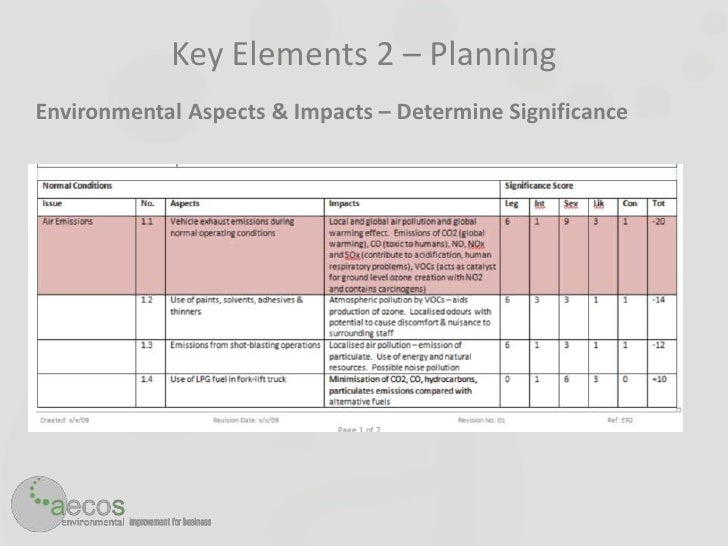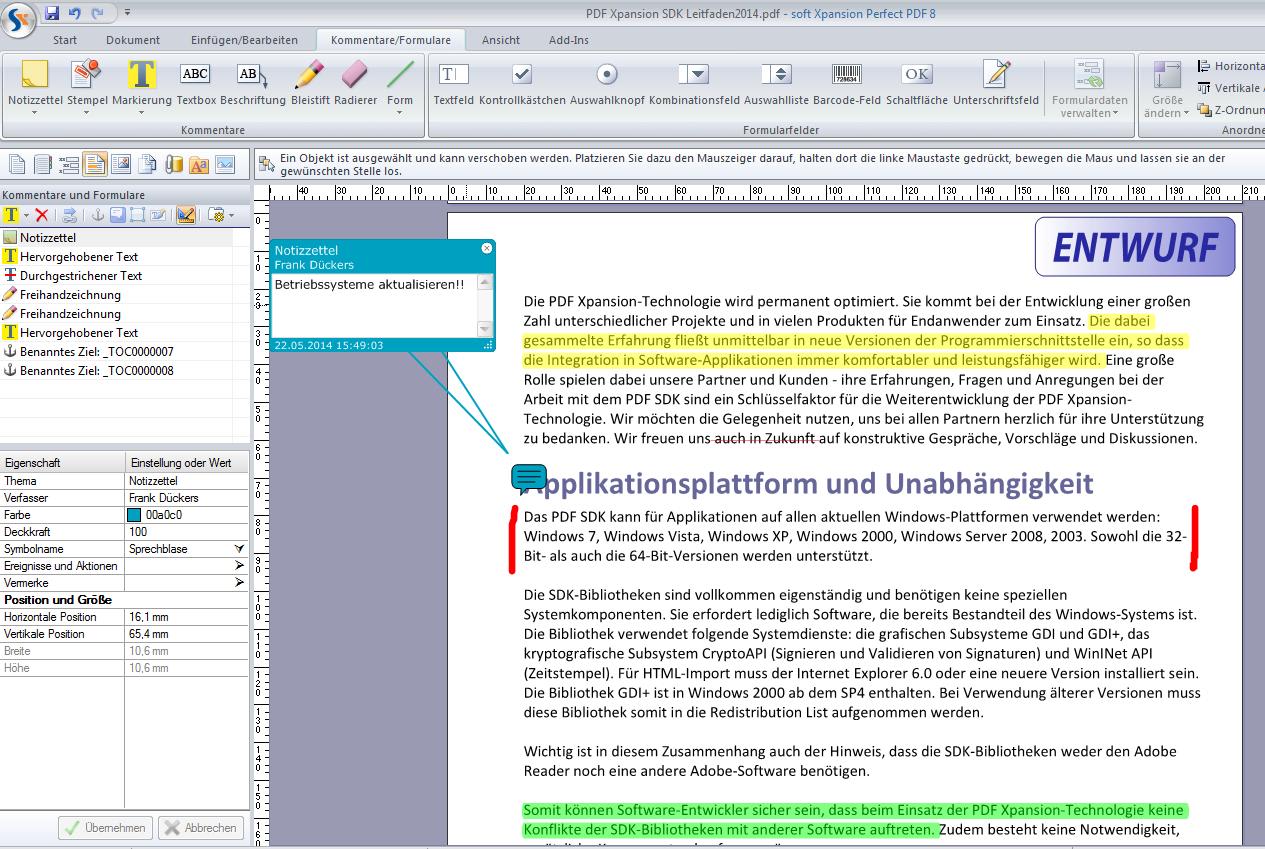Aspect And Impact Register Iso 14001
What is environmental aspects and impacts Nov. Definition of Environment in ISO. Definition of Environmental Impacts in ISO.
Quint, I agree with other posters here that there can't really be a master list of aspects. This will vary from industry to industry and specifically with what the business actually does. But I found the following list extremely useful as a guidleline when going through all the businesses processes to identify the aspects prior to running a two dimensional risk analysis over them before putting them into an Environmental Effects Register for the management. 'Environmental effects to be addressed shall cover present and future, and actual and potential effects, and shall include, but not be limited to, the following issues:.Spills to land or water;.Accidental discharges to the environment;.Emissions to air and odours;.Environmental noise;.Heritage conservation;.Greenhouse effect;.Ozone-layer gases;.Ecosystem protection;.Contaminated land and remediation.' Clearly some may not apply to your business.
Hope it's of some value to you. I agree with others - there is no such thing as a universal aspects list. For manufacturing facilities most aspects fall into one of three categories:' 1 - Stuff that you use - electricity, natural gas, water. 2 - Stuff you don't want to happen - spills, unplanned releases.

3 - The Wastes you produce as a result of day to day operations - waste water, air emissions, garbage, scrap, used oils, scrap cardboard. Category 1 can be prefaced by 'use of' Category 2 can be expressed as 'potential spill of oil' Category 3 usually has one of 20+ adjectives attached to it - used, dirty, soiled, contaminated, broken, damaged, empty, surplus, obsolete, radioactive, spent, waste, oily, scrap, depleted, old, worn, spoiled, superseded, stained We're coming up with a generic list and suggestions. Thanks, everyone!
. If you are confused by the standard clause 4.3.1, you are not alone. One of the most confusing parts of the ISO 14001 standard is the concept of environmental aspects, what they are, and how they should be used by the organization.
Microsoft Office 2000 Standard.iso.[ISO] torrent download,torrent hash is. Microsoft Office 2000. Microsoft Office 2000 Premium [BR] portugues. Size: 1.66 GB, Files: 5, Magnet, Torrent, Microsoft Office 2000 K Plus Pack & English Language Pack.iso 576.22MB Microsoft Office 2000 Premium K CD 1.iso 568.40MB. Microsoft Office (2000) Premium BR portugues ISO zip torrent. Information about the torrent Microsoft Office (2000) Premium BR portugues ISO zip. 
This is an important element of the ISO 14001 environmental management system, as it is the first step outlined in the planning process, so understanding it is key to a good implementation of the ISO 14001 standard. What is an environmental aspect?
Simply put, an environmental aspect is any part of your company’s activities that can interact with the environment, either positively or negatively. This could be chemicals that are emitted into the air from a vent during one of your processes, or chemicals that could be expelled in your wastewater. This could also be taking into account the use of resources that your processes utilize, or the environmental effect of the amount of waste you dispose of. The important thing is to review each of your processes and determine what environmental interactions there are. It is important to look at all factors of the environment when reviewing your processes to determine the aspects.
Environmental Aspects And Impacts Register
I like to think of six different categories when I think of the aspects:. emissions to air. pollution of land. discharge of water. use of materials / natural resources. solid waste management. hazardous waste A seventh that can be considered is other local environmental / community issues.
By reviewing the process against each of these categories, it becomes much easier to visualize how the process can affect the environment, and this is what the environmental aspects are. The difference between control and influence The second thing that is specified in the requirements is to determine if you have control over the aspect, or only influence. Probably the best way to think of this is through an example.
Say you have a manufacturing process that uses a raw material, but makes 5% scrap. You have the control over the process to make improvements to reduce the amount of scrap, and therefore reduce the amount of raw material that is used in the process.
This is an example of an aspect you have control over. A second example that I have personal experience of is a process that has scrap metal for which you need a metal recycle dealer to come and remove the metal. In this case, you do not have any control over how much fuel is used by the dealer’s trucks. They could be well maintained, or poorly maintained, and you wouldn’t know. However, you could choose a metal recycler that is closer to your facility rather than one in a more distant city, because the closer dealer would, by default, use less fuel to remove your recyclable metal than one farther away.
This is an example of how a decision can influence the environmental aspects not directly controlled by your company. What are significant environmental aspects? The ISO 14001 standard is very open about what is meant by “significant” when it comes to determining the significance of environmental aspects. The only requirement is that the company must determine what aspects have, or can have, a significant impact on the environment. The first place to look for a definition would be any legal environmental requirements that are placed on your company’s processes. If any are in place, it is probably safe to say that the process in question can have significant impact on the environment, and should be noted as such.
Iso 14001 Environmental Aspects
A second place to look would be any industry best practices with respect to the environment. If others in your industry are dealing with environmental interaction, you may need to consider them as significant as well. An example would be in the chemical industry, where handling dangerous chemicals requires special training, an indication that the aspect of a chemical spill should be considered significant. Failing any outside indications of what could be significant, it is up to the company to determine a definition and then use it to classify the aspects that the company has identified. Why determine the environmental aspects The whole reason for determining the environmental aspects is summarized in the final requirement of clause 4.3.1 in the ISO 14001 standard; take them into account when establishing and maintaining the environmental management system. The reason for the aspects is to provide the data required to decide what processes need to be monitored and controlled, and which processes are the best targets to provide the best improvements in the environmental impact of your company.
This is also a reason to keep them up to date, as is required by the standard. If your processes change and you do not update how the new process affects the environment, then the data you are using to judge the process for improvement is lacking. This may, in turn, lead to poor results in your improvement activities.
Iso 14001 2015 Manual Pdf
By knowing and controlling the aspects, you are controlling the environmental risks associated with your activities, thus providing good risk assessment and management for the areas where your company processes can impact the environment. Good planning gives good results The whole idea of the ISO 14001 environmental management system is to give your company a framework for assessing how you affect the environment, and how you work to reduce your negative impacts and increase your positive impacts. Determining and maintaining the environmental aspects of your processes is the first step in planning to make a positive change in your company, your surroundings and the world.